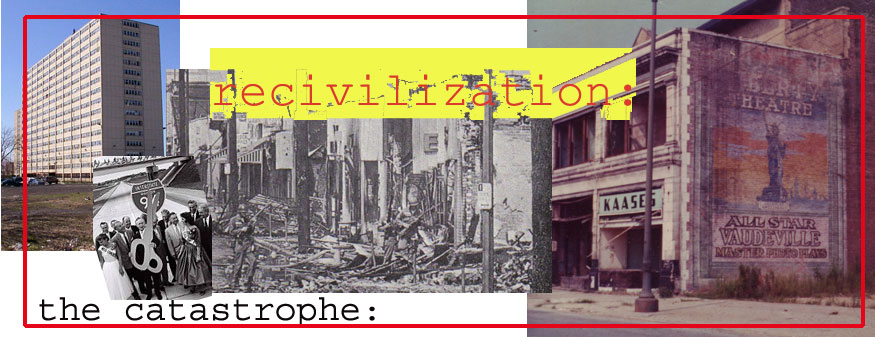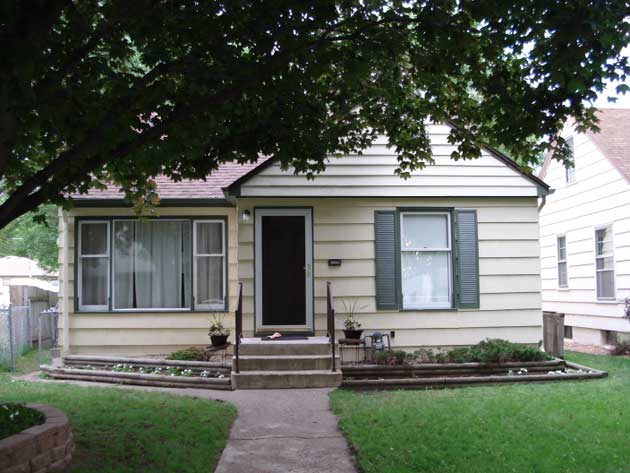

310 the suburban mystique
A honeymoon in Cairo, in a brand new autogyro
Then off to Rio for a drink We'll settle down in Dallas in a little plastic palace Oh, it's not as crazy as you think —a popular song of 1946, 'I'll Buy That Dream', recorded by Harry James' band Suburbia is a straw man, the escapist mythology magnified to a Book of Exodus. Discussing it has generated plenty of heat, but mostly it serves as yet more evidence that the biggest American industry of the postwar era has been navel-gazing. Commentators of the 50's called suburbia 'an entirely new way of living', while a highbrow critic like Lewis Mumford could thunder against the 'child-centered environment...where reality is sacrificed to the pleasure principle.' All the noise only obscured the fact that little really new was happening at all. The suburban pattern is as old as Penn's plan for the 'greene country town' of Philadelphia. Most Americans have always hoped to live in a house at the center of a house lot, and go off somewhere else to work; outside of the biggest and most densely populated cities, most of them would get their wish. Though it did seem like an explosion from the 50's point of view, the development of new fringe neighborhoods, a continuous process in American cities since the earliest times, was simply catching up after the long delay caused by depression and war. This suburban expansion did differ from the ones after the Civil War and World War I in significant ways. First, in scale: the motor that powered it was in a car instead of a trolley, allowing for slightly larger lots and slightly greater distances. Second, nearly all of the development now happened in incorporated suburbs, in which residents could maintain the illusion that they were living in self-sufficient, 'small town' communities, with an outlook and a destiny separate from their city. Suburbs, and suburbanites began to think of themselves as somehow 'different'. Finally, this wave of suburbanization was largely a federal undertaking. The FHA financed four and a half million homes by 1957, almost all suburban, augmented by VA loans for veterans with no down payment. Almost as important was a 1954 change in the tax code that accelerated depreciation for new buildings, making suburbia into a tax shelter. In 1962, a typical year, the government spent $820 million housing the poor, against $2.9 billion in tax deductions for middle and upper-class suburbanites. Washington's policy was to push not only residents into the fringes, but their jobs too. In August 1951, at the height of the nuclear hysteria, President Truman announced his policy for industrial dispersion. Supposedly, this was meant only for 'defense-related' industries, but in practice that turned out to be nearly all of them. Considerable tax breaks, and priority in government loans, would be given to firms that located new facilities far from densely populated neighborhoods, The Department of Commerce drew up an 'Industrial Dispersion Guidebook for Communities'. As the great scholar of suburbia, Kenneth Jackson, put it in Crabgrass Frontier: The prevailing myth is that the postwar suburbs blossomed because of the preference of consumers, who made free choices in an open environment. Actually...most postwar families were not free to choose among several residential alternatives. The result, if not the intent, of Washington programs has been to encourage decentralization. FHA and VA mortgage insurance, the highway system, the financing of sewers, the placing of public housing at the center of ghetto neighborhoods, and the locational decisions of federal agencies and the Department of Defense, to name only the most obvious examples, encouraged scattered development in the open countryside. ..Thus, suburbanization was not an historical inevitability created by geography, technology and culture, but rather the product of government policies. After the wartime compression, the move out of the overcrowded city of war's end did look very much like a popular exodus. At the original Levittown in 1949, people were lined up, camping out, five days before the home sales office opened. Bill Levitt sold $11 million worth on the first day. Buying one was cheaper than renting a flat in New York, and if the rows of bungalows were spare and monotonous, at least there would be a fair-sized yard, and plenty of mod-cons; Levitt himself invented the phrase 'built-in'. Levitt nailed up 17,000 houses at his first Levittown on Long Island, but he was only the biggest and most publicized of the mass-market builders that flourished in the postwar years. Henry J. Kaiser was doing the same on the West Coast, with enormous projects of look-alike homes such as Panorama City, California. In Chicago, there was Park Forest, Rolling Meadows and Meadowdale; in Detroit, Warren, Livonia and Taylor. Every city had them, and every small town, even if it could only manage one or two subdivisions. The new suburban mystique, as rehashed endlessly in the press, presented a very different ideal from the one favored by academics and planners. Instead of a politically-flavored idea of community, Americans were portrayed as favoring an ideal taken from the pioneers on the western frontier. Much of the popular mythology of American neighborliness, mutual aid and community participation comes from these postwar years. William H, Whyte Jr. saw it happening in the new homogenous mass-suburb of Park Forest, Illinois: the population full of PhDs, 'trainees for the big corporations, research chemists with the AEC, captains and majors with the Fifth Army, airline pilots, FBI men... in cheap starter homes none would dream of living in today, but look back on with fondness'. In The Organization Man (1956), Whyte spells out the myth in loving detail: 'Let's take, for example, a couple we shall call Dot and Charlie Adams. Charlie, a corporation trainee, is uprooted from the Newark office, arrives at Apartment 8 Court M-12. It's a hell of a day-the kids are crying, Dot is sick with exhaustion, and the movers won't be finished till late. 'But soon, because M-12 is a 'happy ' court, the neighbors will come over to introduce themselves. In an almost inordinate display of decency, some will help them unpack, and around suppertime two of the girls will come over with a hot casserole and another with a percolator full of hot coffee. Within a few days the children will have found playmates. Dot will be Kaffeeklatsching and sunbathing with the girls like an old-timer, and Charlie, who finds that Ed Robey in Apartment 5 went through officers' training school with him, will be enrolled at the Court Poker Club. The Adamses are, in a word, in-and someday soon, when another new couple, dazed and hungry, moves in, the Adamses will make their thanks by helping them to be likewise.' This bonhomie did really exist; it came from the shared experience of the war and its disruptions. A whole bright, expectant generation was getting its life together again, sharing tools and lawn mowers, throwing clambakes, sitting at PTA and club meetings, pushing shopping carts. Conspicuous in retrospect are the people not invited to the clambake. Zoning and the prejudices of the incorporated suburbs insured that there would be few low-income people in the new promised land, and very few blacks. Developers like Levitt kept their new communities strictly segregated long after such practices had become illegal. In some places, zoning could be taken to extremes to ensure that suburbs would remain class-based preserves. In the 50's, Westchester County, New York reexamined its zoning code and found it a little too liberal; they changed it to reduce the number of possible inhabitants by one third. The phrase 'snob zoning' became common to describe the phenomenon; in the 60's there would be several challenges to it in the courts, as in the famous case of Mount Laurel, New Jersey. Most of them lost. The continuous incorporation of new suburbs served the same goals. Often, incorporation was driven by developers and owners of important commercial or industrial properties, seeking to avoid annexation and paying their fair share of a city's taxes. The Lakewood neighborhood in Los Angeles County, leaning towards annexation by Long Beach (not Los Angeles) in the 50's, was subverted by a big shopping center owner named Ben Weingart, who successfully campaigned to defeat it. Weingart developed the 'Lakewood plan', whereby parts of Los Angeles County could become fortress suburbs while avoiding many of the costs and responsibilities of incorporation, by contracting with the County for all municipal services. It was a legal fiction that left the status quo intact, and it was copied by suburban areas all over Los Angeles. Peculiarities of state laws confirmed similar splits between inner 'city' and 'suburban' county, as already present in Baltimore and St. Louis; not surprisingly, such arrangements would result in some of the most troubled and schizophrenic cities. In most states, however, incorporation was necessary for control over the crucial matter of land use, through the creation of a zoning map. Everyone was in such a hurry, the pattern of the 20's suburb got entirely lost, along with that era's design sophistication. The new pattern, while formally equivalent to the old one (commercial strips along the main roads, with fields of single-family housing in between), came in a stripped-down version. The new men, the big package developers, set the tone for the rest, cramming as many lots as possible onto the land available. With both eyes firmly on the bottom line, very few of them bothered about neighborhood centers or amenities. Reflecting economic conditions, houses in the 40's and early 50's were smaller, sometimes as little as 600 sq ft, and cheapness was definitely in. Many of the cost-cutting innovations pioneered by Levitt found their way into the national vernacular: concrete slabs instead of basements, concrete patios in back instead of front porches, 'carports' instead of garages, aluminum windows and siding; many homes were left unfinished upstairs, under the gables, for the homeowner to deal with later, when the baby-boom kids started popping out. Popular mythology always appended the adjective 'leafy' to 'suburb', but most of these postwar mass developments would hardly qualify. Developers commonly leveled all the trees and natural features of a subdivision before building on it. New residents would be lucky to get a bag of grass seed and a three-foot Norway maple sapling, and for at least a decade most of the new neighborhoods looked a lot like the government camps and projects many of its residents had just left. It ain't much, but it's ours. 'Little boxes made of ticky-tacky' attracted commercial developments to match. 'Shopping centers' would appear; some of them had architectural pretensions, but the standard form for every new neighborhood was the strip mall, built of cinder block with a brick or stucco veneer on one side; it came in various sizes, but it would always be set in the middle of a parking lot. Every working part of the neighborhood, in fact, would be hidden behind a parking lot, from the theaters to the doughnut shops to the new suburban 'city halls'. Once retailers discovered they could use convenience to break downtown's monopoly on serious shopping, that business would be changed forever. Now, the best shops would generally seek to locate right on the fringe, in the poshest new developing suburb. When that suburb settled down to ordinariness, and a new one started growing out beyond it, the shops would move again. The new order included another 'built-in' feature: planned obsolescence. The suburbs had plenty of room for manufacturing too, in a time that saw the increasing prominence of the one-storey manufacturing facility. Industries always seek cheap land, and the one-storey trend only amplified a tendency to suburban location that had always existed. One-storey reduces the risk from fires, and so lowers fire insurance rates, and they were perfect for continuous assembly lines. Electric light and mechanical ventilation made it less necessary for workers to be near windows. The shift from steam-and-belt systems to electric power helped make it possible to rearrange a single, broad factory space to fit any contingency. One-storey also makes for more efficient handling of goods. The gradual shift from rail to road for freight transport only gave an added impetus to a process that was already in place. Just about everything was attracted to the fringe-everything except public transport. City transit lines proved consistently slow about expanding services to the new neighborhoods where they might have found plenty of paying customers. Anyhow, they never had much money for capital improvements; roads received overwhelming public subsidy, while the declining bus lines, still mostly private, got none. All through the 1950's and 60's, suburbia was ridiculed, or treated to a more sophisticated condemnation in books like Whyte's The Organization Man. Everyone railed at its conformity, its seclusion of women and worship of children, and the cultural sterility of suburban life. The critics were over a century late, for what was happening in the 50's was only the logical continuation of the pattern of living Americans had set as an ideal back in the days of Andrew Jackson Downing. And even if it came on the cheap, homeownership for the average family was nothing to be disparaged. Herbert Gans, the Great Debunker of the 50's, respectfully and correctly explained the suburbanites' aspirations and achievements in The Levittowners—he spent two years living among them. Outside of their design and exclusionary zoning, perhaps the new neighborhoods weren't so bad after all. The context for all this is the decline of city centers, something that might have happened even if the city had captured its new fringe growth by annexation. The softening of the center was still slow and gradual in the 50's, a reality that was generally above the horizon only of real estate men and developers. Cincinnati makes a good example. In 1940 the city had 11,500 downtown residents, in 1960 only 6,500; in 1948, 1,054 retail establishments, in 1958 only 854. In 1945, 209,000 people came downtown on an average business day, in 1960, only 171,000 did. Downtown's property tax receipts as a percentage of the city total were 21% in 1945, 17% in 1955. Observers noted the same effect in nearly every other city, regardless of its degree of prosperity: department stores closing, fewer restaurants, theatres and night clubs, more vacant shops, empty streets at night and on weekends, little new building. Can you blame the suburbs for all this, as nearly every commentator has over the last fifty years? Decidedly not! We can't say this too often: Postwar suburbanization was part of a continuing outward flow that is as old as the United States. The difference was the car, which made possible a less dense style of fringe building, and changed the way people chose to get around for work, shopping and entertainment. |
|

|